October 13, 1999, day 5
Be Here When it Happens
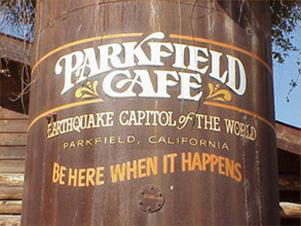
Parkfield
Be Here When it Happens

Parkfield
The sign in front of the Parkfield Cafe proclaims "Earthquake Capitol of the World." Since 1857 they have had 6 magnitude 6 earthquakes in Parkfield. Noticing that there was a quake every 22 years on the average, the USGS installed more sensors in Parkfield than anywhere else on earth, ready to catch the quake due in 1988. In 1999 that quake is 11 years overdue but the USGS is still watching. Waiting to learn as much as they can. They'd love to catch some signal that warns them of an impending earthquake, a signal that would let them issue an earthquake warning not only for Parkfield but for other earthquakes on the San Andreas and around the world.
Rich Liechti from the USGS was our host. Program time found us once again standing on the San Andreas fault this time amid an array of instruments. The most unique one was a line of one meter high white posts that stretched along the depression that was the fault, a second line crossed the fault at right angles. Two video cameras were positioned to photograph the fault and the posts in hopes of catching the earthquake waves as they passed through. Normally the cameras record a few frames every 6 minutes. In case of an earthquake, the cameras are triggered to operate at full video speed. There are seismometers in the base of each camera mount that sense earthquakes, there are also remote seismometers that can trigger the cameras before the earthquake waves reach here. The radio signals from the distant sites travel at the speed of light, much faster than the speeds of earthquake waves. So they can race ahead of the waves and start the cameras rolling.
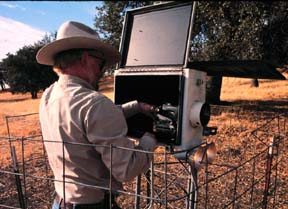
Rich Liechti of the USGS loads a Fuji video cassette into the Sony videocam that is triggered by seismographs to watch the San Andreas fault in case of an earthquake.
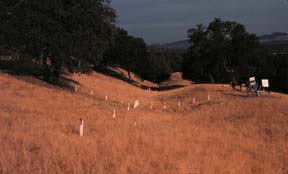
This is what the camera sees. An array of white posts running along and also crossing the depression that marks the course of the San Andreas fault. On the right is a second camera watching the same set of posts.
Realizing that the cameras operated in time-lapse mode all the time I asked Rich the favorite moments he has caught on film. He said that it was fun to watch the day go by, as the shadows of the trees shortened then lengthened and moved around as well, then to see night come on and to hear the crickets and frogs too. He caught the world turning white from a snowfall and then turning brown again quickly under the heat of the sun. Groups of cows would wander in to the fault trace then jump around from post to post scratching for the time lapse camera, groups of geology students would do the same thing, their behavior looked a lot like that of the cows, minus the scratching. His favorite moment however was when a deer looked right into the camera and sneezed.
He has caught several magnitude 5 quakes with the cameras. They happened at night. But two floodlights beneath each camera lit the scene. The wire on a fence shook back and forth, leaves were shaken off the trees, and birds were roused from their night time perches. He was happy that these quakes tested the system and showed that it worked.
Ellen showed him a piece of red and green chert. He said it was an excellent example of leverite, as in leave-er-right there. However, he went on to say that it was a mixture of red chert and green serpentinite.
At night we did a second program. The Exploratorium was having a special evening event for corporate funders and wanted a live webcast from the faultline crew. We went up to a local hill top with Duane Hammon, the town teacher, he had 17 students in a one room school house. His students attended grades K through 6. In the evenings he went up to his laser observatory and measured the distances to other nearby hill tops.
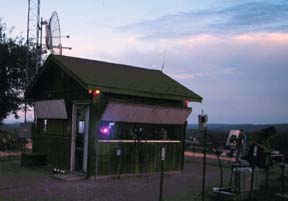
Duane opened the shutters on the building that houses the lasers. Then shot the red and blue lasers through an 8 inch diameter telescope to a distant matching telescope that reflected the light back. Instruments measure the travel time of the light and so measure the distance to the reflector to the nearest millimeter.
The laser beam coming from the telescope reminded me of a question I always asked my students but had never done. "If you look into an 8 inch diameter laser beam with your eye, what do you see?" What do you think? Recall that the laser beam is a plane parallel beam of light. Just like the light from a distant star. So that when your eye focusses on the light you see the eight inch diameter beam of light as a point, just like a star. At least that was the prediction, and I did see a point, at least for the red light. The blue light remained fuzzy, I couldn't focus it, others in the group with younger eyes could.
Before I looked in to the laser beam with my eye, I did the calculation for laser power density three times. That's a real test of your computational confidence, imagine the following exam question,"you are going to look into a laser beam calculate the power in the beam and decide if it is safe or not." Your eyesight depends on the correctness of your answer.
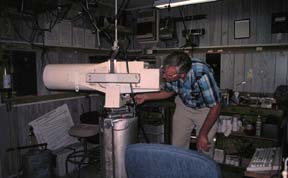
Duane was glad to receive a visit from a laser physicist. "At last," he said," someone has come to visit that I get to ask questions about lasers." However, Duane knew a lot about lasers and didn't need to ask me much at all.
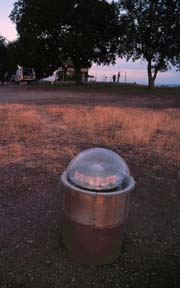
After 14 years of measurements Duane is being replaced by robotic monuments. The monuments will measure their position every 10 minutes year after year, extending the data set Duane has been collecting. The USGS is paying Duane to continue his measurements for a year so that his data sets and those of the robot monuments will overlap.
Duane took pleasure in pointing out to us the beauty of the surrounding countryside as night fell. He was right, in the crisp fall evening he was working in the middle of spectacular country. He loved his job and it showed. I know he'll miss coming up here when the robots take over.
Visit the Exploratorium web pages for more information on faults:
Go to the Exploratorium Faultline site
|
Scientific Explorations with Paul Doherty |
|
11 Oct 99 |